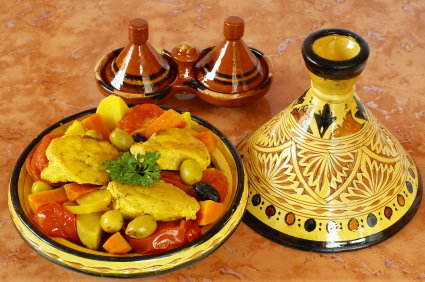
Originating in Northern Africa—specifically Morocco—tagine (sometimes mispronounced tangine) is a stew made of meats and vegetables and traditionally cooked in a conical clay pot for which the cuisine is named after. The tagine pot's shape is meant to allow steam to rise, condense and drip back down into the stew. Tagines are traditionally prepared on top of a portable clay majmar under which people put hot coals. Practically anything can be turned into a tagine: meat, chicken, fish, vegetables and some even make it with meat and fruits. Every part of the country has its regional tagine dish and different ways of preparing it. Because this meal takes a long time to prepare, the woman of the house starts preparing the lunch tagine as soon as breakfast is over.
Moroccan cuisine is filled with intense flavors and unique combinations. While other African food is defined by its spiciness, Moroccan food is characterized by its fusion of sweet and savory tastes. Specialties vary regionally, but certain foods are widespread such as khoobz (pita bread), kefta (minced lamb or beef with spices) and mechoui (roasted stuffed lamb). Generally, Moroccan dinners usually include mezze (different small salads), couscous, a variety of tajine and bastilla (similar to a meat pie). Popular desserts include sfaa (couscous with cinnamon, dried fruit, nuts and cream) and various almond-based indulgences. Mint tea is one of the most common beverages, as is coffee and fresh-squeezed orange juice.
You can buy simple tagine pots from World Market, or more elaborate tagine pots from Williams-Sonoma.
Ingredients:
- ½ Chicken, in pieces
- 3 medium carrots, peeled and cored (if core is bitter) and sliced in half lengthwise
- 1 large peeled potato, cut in 1/2 inch thick rounds
- 1 large green bell pepper, cut in chunks
- 1 medium red onion, cut in 1/2 inch thick rounds
- 2 medium tomatoes, cut in 1/2 inch thick rounds
- Handful of pitted green olives
- 2 cloves garlic, sliced
- 2 teaspoons ground ginger
- ½ teaspoon ground pepper
- 2 teaspoons paprika
- ½ cube or 1 teaspoon chicken bouillon powder
- Dash of yellow food colorant powder, or a few strands crushed saffron
- 1-2 teaspoons salt (to taste)
- 6-8 tablespoons of olive oil
- 1/4 cup of water
Preparation:
- Splash 4 tbsp of oil on the bottom of the tagine
- Layer your ingredients evenly in the tagine in this order: carrots, chicken, potatoes, bell pepper, red onion, tomatoes, garlic, ginger*
- When you get to the spices and salt, sprinkle them evenly over the vegetables
- Spread your olives on top
- Drizzle the olive oil all over everything
- If water is needed, add it now
- Close your tagine and cook until your vegetables are tender, on a very low heat, this may take up to one hour**
- Once it's cooked, turn off the heat and you can drizzle olive oil on top if preferred
- Let the tagine rest for about 10 minutes to cool off, and enjoy!
* The carrots must be on the bottom, and the chicken pieces should be on top of the carrots, not touching the bottom of the tagine. When the carrots start to burn they add delicious flavor and protect the rest of the ingredients, but if anything else burns that's not going to taste very good.
** Make sure you have liquid in the tagine or it will burn. Watch out for too much liquid, or it will bubble over.
Recipe by Ian Williams